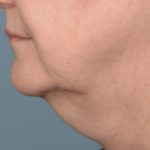
Despite all of these facelift maneuvers, the neck shape may not always be stable afterwards. Aging will obviously change the neck with time but I am referring to the phenomenon of rebound relaxation. This is the change in the neck that will happen to some patients six to twelve months after their initial facelift. This may appear as looseness of the central neck skin, the appearance of lumps or fat areas along the jowls and submandibular areas, and recurrence of platysmal bands. These developments are unsettling to patients as they understandably believed that their relatively recent effort physical and economic sacrifices would provide a more long lasting effect.
In reality, and I advise all my Indianapolis facelift patients, that bothersome rebound neck relaxation will happen in about 10% to 15% of patients. It is more likely in patients with fuller necks and more severe neck sagging but not exclusively so.

Sometimes the skin excess may be satisfactorily worked out by the wide undermining of the skin from the liposuction. But is most cases, removal of submental skin will be needed. This can be done one of two ways. The submental incision can be extended slightly and a horizontal ellipse of skin can be removed provided an anterior tightening and keeping the scar parallel to the mandibular border. The other approach is to excise a vertical limb of skin, creating a T-shaped submental scar. As long as the this vertical scar does not exceed 2 cms, it is not seen and will heal in an inconspicuous manner.
A secondary submentoplasty can help touch up a facelift that has developed some rebound neck relaxation or a visible bunching of tissues under the chin. It is a simple procedure that can be done under either local or IV sedation and has a minimal recovery. If the initial facelift is a 10 on the recovery scale, a submentoplasty would be a 1. Any patient undergoing a facelift should be aware that this secondary procedure may be needed to help achieve or maintain the desired neck result.
Dr. Barry Eppley
Indianapolis, Indiana



